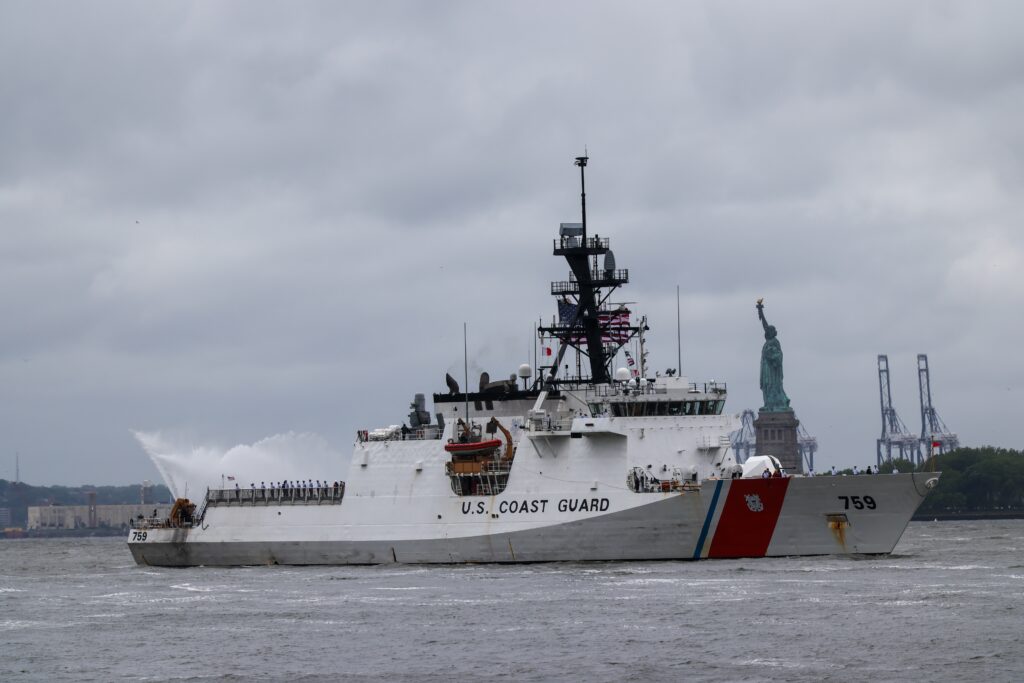The U.S. Coast Guard will no longer classify the swastika, an emblem of fascism and white supremacy inextricably linked to the murder of millions of Jews and that more than 400,000 U.S. troops died fighting against in World War II, as a hate symbol, according to a new policy that takes effect next month.
Instead, the Coast Guard will classify the Nazi-era insignia as “potentially divisive” under its new guidelines. The new policy, set to take effect Dec. 15, similarly downgrades the definition of nooses and the Confederate flag, though display of the latter remains banned, according to documents reviewed by The Washington Post.
Certain historic displays or artwork where the Confederate flag is a minor element are still permissible, according to the policy.
Though the Coast Guard is not part of the Defense Department, the service has been reworking its policies to align with the Trump administration’s changing tolerances for hazing and harassment within the U.S. military. In September Defense Secretary Pete Hegseth directed a review and overhaul of those policies, calling the military’s existing standards “overly broad” and saying they jeopardize U.S. troops’ combat readiness.
The Coast Guard did not immediately provide comment.
A Coast Guard official who had seen the new wording called the policy changes chilling.
“We don’t deserve the trust of the nation if we’re unclear about the divisiveness of swastikas,” the official said, speaking on the condition of anonymity due to a fear of reprisal.
The Coast Guard is a military service branch under the Department of Homeland Security and the purview of Homeland Security Secretary Kristi L. Noem. But the service, which has been central to President Donald Trump’s increased focus on homeland defense, has been swept up like the others in the administration’s rash of leadership firings and broader targeting of military culture.
Former Coast Guard Commandant Adm. Linda Fagan, the first woman to lead a branch of the U.S. military, was fired on Trump’s first day in office for what administration officials said then was her focus on diversity initiatives and her handling of sexual assault investigations.
Within days, Fagan’s replacement, acting commandant Adm. Kevin Lunday, ordered the suspension of the Coast Guard’s hazing and harassment policy that, among its other guidance, said explicitly that the swastika was among a “list of symbols whose display, presentation, creation, or depiction would constitute a potential hate incident.” Nooses and Confederate flag also matched that description under the previous policy.
Lunday was later nominated by Trump to become the service’s commandant. His Senate confirmation hearing was held Wednesday, and he was due to meet with lawmakers Thursday. It is unclear when the Senate Commerce, Transportation and Science Committee, which has jurisdiction over DHS, may vote to advance Lunday’s nomination.
The Pentagon, where Hegseth has argued that prior administrations’ focus on racial diversity has harmed military recruiting, referred questions on the Coast Guard’s policy to DHS, which did not immediately respond to a request for comment.
The new policy, drew concern from Commerce Committee member Sen. Jacky Rosen (D-Nevada), who called on the Trump administration to reverse the changes before they take effect.
“At a time when antisemitism is rising in the United States and around the world, relaxing policies aimed at fighting hate crimes not only sends the wrong message to the men and women of our Coast Guard, but it puts their safety at risk,” Rosen said in a statement to The Post.
In Germany, public display of certain Nazi emblems, such as the swastika, is illegal and can be punished with a fine or imprisonment of up to three years. Exceptions are made if the symbols are used for educational, artistic, scientific or journalistic purposes.
Rosen noted that the wording in the new Coast Guard policy “could allow for horrifically hateful symbols like swastikas and nooses to be inexplicably permitted to be displayed.” The new guidance says that if a “potentially divisive” symbol is reported, supervisors should inquire about it. After consulting their legal office they may order the symbol’s removal but there’s no further guidance requiring that it be taken down.
The new Coast Guard policy also limits the amount of time that service members have to formally report the display of a noose or swastika — which could be enormously problematic for personnel at sea. Like the Navy, Coast Guard members can be deployed for months at a time. The new policy gives them 45 days to report an incident whereas the previous policy did not have a deadline other than to advise that Coast Guard members who see a potential hate incident “should immediately report it to a member higher in their chain of command.”
That 45-day deadline will have a chilling effect, said the Coast Guard official who had seen the new policy.
“If you are at sea, and your shipmate has a swastika in their rack, and you are a Black person or Jew, and you are going to be stuck at sea with them for the next 60 days, are you going to feel safe reporting that up your chain of command?” this Coast Guard official said.
Previous guidance put in place in 2019 said Coast Guard commanders could order swastikas, nooses or other symbolsto be removed even if it was determined the display did not rise to the level of a hate incident. That policy was enacted months after a Coast Guard officer, Lt. Christopher Hasson, was charged with plotting a large-scale attack on Democratic lawmakers, including then-House Speaker Nancy Pelosi. In securing his conviction, prosecutors cited evidence in his case showing Hasson to be an avowed white nationalist.
Over the past several years each of the other military services has reworked their policies on extremism within the ranks. That was a response, directed by the Biden administration, to the Jan. 6, 2021, attack on the U.S. Capitol perpetrated by Trump supporters angry that he lost his reelection bid.
Hundreds of military veterans were implicated in the Capitol riot, and subsequent law enforcement investigations found numerous ties between those veterans and extremist groups such as the Proud Boys. Those convicted of crimes associated with their participation in the Capitol attack were pardoned by Trump shortly after he took office this year.
The changes to the swastika and noose classification were part of a broader effort by the Coast Guard to remove the concept of hate incidents from its regulations.
“Conduct previously handled as a potential hate incident, including those involving symbols widely identified with oppression or hatred, is processed as a report of harassment,” the Coast Guard said in its new policy, which was recently published online. “The terminology ‘hate incident’ is no longer present in policy.”
Each of the military services is also reviewing its harassment policies in response to Hegseth’s directive, though unlike with the Coast Guard, any wording specific to swastikas would likely appear in their separate extremism guidelines. It does not appear there is wording addressing swastikas specifically within those policy documents.
In the Air Force and Army for example, current policy prohibits “knowingly displaying paraphernalia, words, or symbols in support of extremist activities or in support of groups or organizations that support extremist activities, such as flags, clothing, tattoos, and bumper stickers, whether on or off a military installation.”
In 2007 two incidents involving nooses within the Coast Guard drew national attention. That summer, a Black cadet at the service’s officer training academy found a noose in his sea bag while aboard a Coast Guard vessel. The next month an instructor discussing race relations in response to the first incident reported a noose was left in her office.
Kate Brady in Berlin contributed to this report.
The post U.S. Coast Guard will no longer classify swastikas, nooses as hate symbols appeared first on Washington Post.




